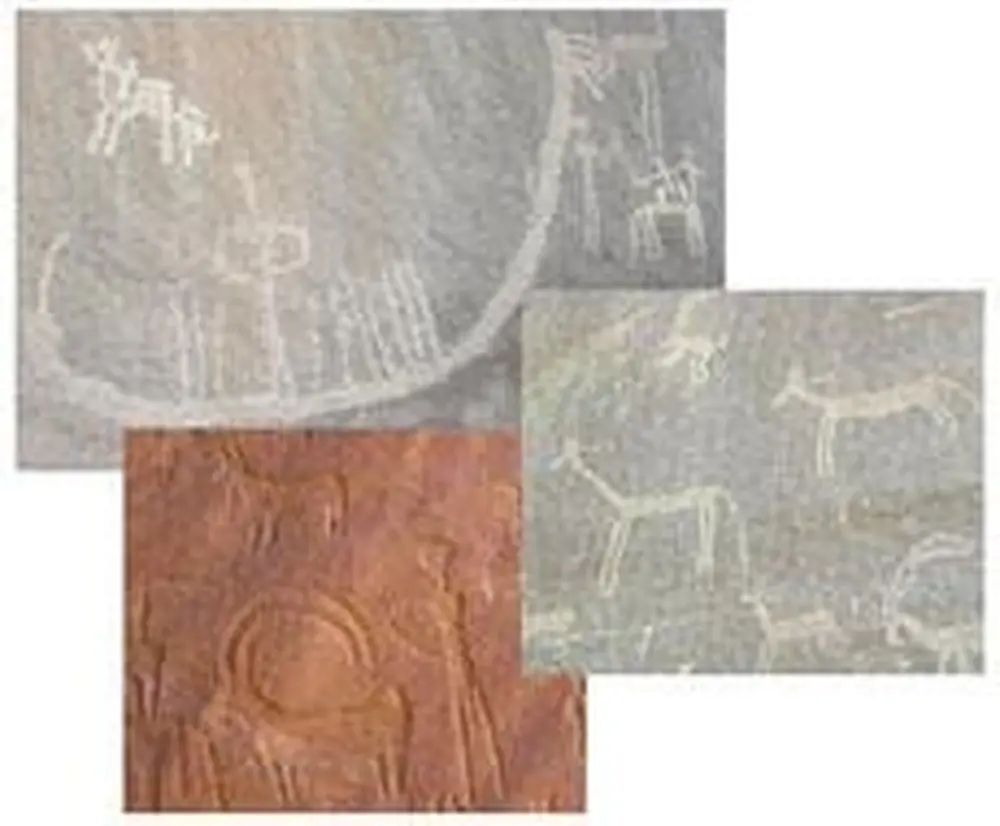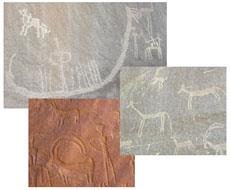

When Douglas Brewer ventured deep into the Egyptian desert this year, he expected to find possibly 100 examples of "rock art"-evidence of ancient civilization. What he actually found were well over 1,000 examples-a treasure trove of rock art.
The desert art, which was pecked or sometimes incised into large rock faces, depicted elephants, ostriches, giraffes, and many hunting scenes. But perhaps strangest of all was the abundance of boats depicted in the art. After all, this area was far from any body of water, says Brewer, a professor of archaeology in LAS and director of the Spurlock Museum in Urbana.
According to Brewer, this find may have raised more questions than it answered. "I went out to demonstrate the existence of the desert culture in ancient Egypt," he says. But after preliminary evaluation of the rock art, it is hard to tell whether it is the work of an independent desert culture.
Brewer made the trip this May and June with Carl Weibel from the Illinois Geological Survey and Dan Blake, a retired U. of I. paleontologist. For security purposes, they were given military protection to the edge of the desert. From there, a skilled Egyptian guide drove them 150 miles into the desert in a vehicle that occasionally became stuck in sand. They braved 130-degree temperatures at mid-morning; and at night, they slept on sheets directly on the sand, which was still toasty from the day's heat.
Brewer says the desert people of ancient Egypt lived in the shadow of the great culture that developed in the famed Nile Valley. As he puts it, "This remote desert culture has always been the pariah. Ancient Egyptians looked down on them."

Even today many people do not believe a complex culture existed in the eastern desert of ancient Egypt. But evidence of rock art could shatter this image, especially if the art depicts domesticated animals and crops-as was the case with the rock art discovered by the Illinois team.
However, the rock art they found has a striking similarity to the type of art seen on the earliest pottery and tombs in the Nile Valley. Therefore, Brewer says, it is possible that the art was the work of Nile Valley pastoralists who took their cattle out in search of grazing land.
"I'm not so sure now that the rock art was the work of an independent desert culture," Brewer explains. "We'll have to go back out and take more detailed photographs of the artwork the second time around to get a better understanding of what's out there."
Their first trip primarily focused on simply determining whether the rock art could be found-something they accomplished in spades.
Rock art was often created by ancient people while grazing their animals. So Brewer's theory was that the art would be more abundant on specific soil types that could produce grasses under the rainier conditions that existed in the area from 3,000 to 5,000 B.C. This notion proved to be extremely effective in locating hot spots for rock art.
Brewer's fascination with Egypt stretches back to his days as a doctoral student in the 1970s. He had originally planned to focus his work on Iran. But on the very day that he was scheduled to fly to Iran-his plane was even on the runway-Iranian militants took hostages in their infamous 1979 attack on the American embassy.
When the Iranian crisis thwarted his plans, Brewer shifted his attention to Egypt, and he made it his life work, visiting there numerous times. On earlier trips, he has encountered Muslim fighters who nearly mistook his group for Israeli soldiers; he has stayed with Bedouin nomads; and he has run across many types of wildlife, including a horned asp-the same species that is believed to have bitten Cleopatra. (Brewer nearly stepped on the highly poisonous asp by accident.)
In one of his most unexpected discoveries in Egypt over the years, Brewer and his fellow researchers once decided to get rid of a notorious speed bump that had always given them bone-rattling jolts whenever they drove over it near their dig site. As it turned out, this "speed bump" was really a 12-foot statue of the pharaoh Ramses II buried close to the soil surface. The statue now stands in an Egyptian museum at Luxor.
On this most recent trip, the rock art they discovered probably will not wind up in a museum, due to its size and fragile nature. Most likely, he says, the Egyptian Antiquities Service will keep the location of the art secret to prevent thieves and vandals from destroying the work.
As for the question of whether this art comes from a complex culture in the ancient desert, that remains an Egyptian mystery for now. One of Brewer's colleagues at Cambridge University believes strongly that the origins of ancient Egypt can be found in the desert.
"But we just don't know," Brewer says.


